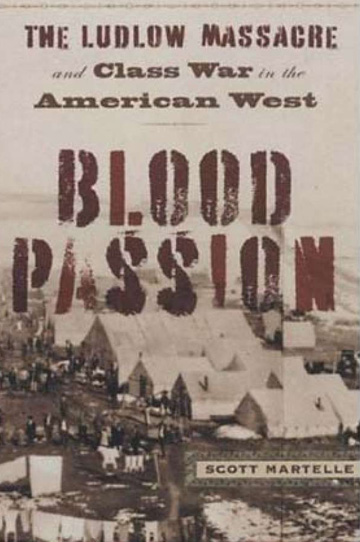
A Balanced Look at Deadly Colorado Miners Strike
August 5, 2007 | San Francisco Chronicle
The photograph shows two straight lines of mourners marching over fresh snow, snaking back through the rugged company town toward the mountains. The picture was taken almost 100 years ago, but you can still see the cold: The gray sky moves by hugely overhead, and chimneys blow smoke; the men – they are almost all men – wear hats and slump at the shoulders, and the horses’ glistening flanks give off steam. The mourners follow a carriage bearing the body of Louis Tikas, a Greek union organizer who helped lead coal miners on a failed 15-month strike against the Colorado Fuel and Iron Co. in 1913 and 1914. Tikas was captured by company thugs during a gunbattle, disarmed, cracked in the skull with a rifle butt and shot in the back three times. The picture calls to mind the famous photos of Catholic marchers at the Belfast funeral of IRA hunger striker Bobby Sands 67 years later. They, too, came to show their outrage and, ominously, to display their angry numbers.
The Colorado miners had more to avenge than one fallen rabble-rouser. For seven months they had been on strike and in a state of more or less open insurrection. Kicked out of their company homes when they walked off the job, they built a tent colony for themselves and their families. But after months of guerrilla war and shootouts with the Baldwin-Felts detectives hired to protect the mines and the strikebreakers, the miners were rousted from their camp. Company men machine-gunned the tents and then set the place ablaze. Two women and 11 children who had been hiding underneath a tent in a foxhole that doubled as a birthing parlor suffocated as the fire overhead sucked up all the oxygen. Tikas was killed later that day.
The similarities between the Ludlow Massacre and the Northern Ireland troubles don’t end with funeral photographs. In both cases, a powerful minority denied basic civil rights to an unruly majority, fearful of giving the masses their lead lest they keep making demands. The majority had reasonable requests – here, an eight-hour workday, pay in dollars rather than scrip, and, critically, union recognition – but when frustrated, turned to violence and soon became intractable. Reprisals followed, and then all-out war. More than 75 people died during the coal strike in Colorado (more than half of them company guards), making it one of the most violent episodes in American labor history.
Too frequently, events surrounding the Ludlow Massacre have been the subject of one-dimensional folklore rather than serious analysis. Howard Zinn, for instance, wrote admiringly of “the undeterred spirit of rebellion among working people” who rose up against their oppressors and fought hard against the company. To Scott Martelle, a reporter for the Los Angeles Times, the miners seemed anything but valiant as they mobbed in their hundreds around a strikebreaker’s wife, throwing rocks and screaming imprecations. Or when they assassinated company men at point-blank range. And as for their treatment of those who crossed the picket line, forget about eggs lobbed against train windows: In Ludlow, a scab deserved nothing less than a slug, and he frequently got one.
If Martelle’s book, “Blood Passion,” refuses to give a free pass to the Ludlow strikers, it is by no means a shill for management. The company hired hundreds of unsavory men who baited the strikers, searched their tents without warrants and tortured prisoners held without charge. Colorado Fuel and Iron was a Rockefeller concern, and the absolute refusal to recognize the union or hold negotiations came from the top – just as Mrs. Thatcher made the decision not to grant political status to IRA prisoners. The Rockefellers’ man in Colorado, Lamont Montgomery Bowers, wore a smart suit and a twitchy push-broom mustache and couldn’t understand what all the damned fuss was about. After a heated argument with a federal mediator, Bowers tallied it up and – no surprise – came out on top:
“I wound him into kinks and beat him at every point. All his arguments were silly and amounted to no more than a busted bubble. Gosh, he was a big chap, but his cause is too plainly in behalf of unionism and I had him sweating and hamming like a half choked calf eating pumpkins.”
The right to bargain collectively has been enshrined in federal law for decades, but the Ludlow Massacre nevertheless serves as a cautionary tale about unregulated labor markets, not to mention an intense and dramatic moment in American history.
Martelle’s excellent book captures it with a journalist’s flair for narrative and a historian’s penchant for making the necessary inferences where they belong: on the page for all to see. Although more context would have been useful, Martelle legitimately chose to keep the story tight, focused and crisp.
But like any book that follows two parties at each other’s throats, it doesn’t make for uplifting reading.